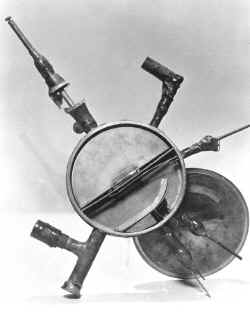The One-Electron Cyclotron

Every student of quantum mechanics studies the simple system of an electron orbiting in circles in a magnetic field. But even physicists may be surprised that the experiment is a lot harder than the math. Until recently, experimenters could directly probe isolated electrons in only their ground state and first excited state without destroying the system during the measurement. But in the 16 August PRL a pair of Harvard researchers shows how to trap a single electron in a magnetic field and coax it into four different excited energy levels. This “quantum cyclotron”–an example of an “artificial atom”–could lead to a closer investigation of basic quantum mechanics and to extremely precise measurements of some fundamental constants of nature.
In the past, researchers have successfully used several different methods to create artificial atoms. “If you can build your own designer atom, you get a superb way to learn about reality,” says Gerald Gabrielse of Harvard University. The “atom” that Gabrielse and his Harvard colleague Steven Peil built consisted of a single electron trapped in a magnetic field. They used a device called a Penning trap to confine an electron in a cavity with electric fields. They then applied a magnetic field to the trap, causing the electron to execute two different types of motion simultaneously: circular orbits perpendicular to the field and vertical (or “axial”) drifts parallel to it.
The magnetic field restricted the electron to a textbook set of quantum states with evenly-spaced energy levels (known as Landau levels) which are akin to the levels in a real atom. The orbiting electron is also reminiscent of cyclotrons that circulate large numbers of charged particles in a magnetic field. The Harvard team’s experiment is the quantum limit of those machines–the first quantum cyclotron.
To get the electron into its lowest energy level, the team cooled the Penning trap down to just a few degrees above absolute zero. But even at 2 K the electron could absorb enough thermal energy from its surroundings to jump into higher energy levels on its own accord several times per hour. At 80 mK, however, the electron remained in the ground state for many hours, and the researchers could completely control the electron, forcing transitions to higher levels at a predictable rate by applying microwaves to the cavity. 80 mK is 50 times colder than any other lab has achieved for an isolated elementary particle.
The other tricky part of the experiment involved measuring the quantum states of the electron without disturbing it, contrary to conventional quantum mechanical wisdom. Gabrielse and Peil circumvented this problem by applying a slowly oscillating electric field parallel to the magnetic field. The electric field caused the electron to oscillate in the axial direction–motion that the team monitored by detecting the current induced in a nearby resonant circuit. They observed transitions between energy levels by measuring changes in the natural frequency of the axial motion, so they deduced the circular orbital motion without directly disturbing it. The team cleanly observed staircase-like changes in energy levels as each photon was absorbed or emitted, and they could even measure the electron’s temperature by counting the number of transitions into excited states.
Gabrielse and his group are already working on measuring the magnetic moment of the electron with the new system. But Daniel Kleppner, of the Massachusetts Institute of Technology, thinks that the experiment is significant because it is a novel way to clearly demonstrate basic quantum mechanical principles. “New methods usually lead to a lot of new science,” he says.
–Meher Antia
Meher Antia is a freelance science writer.


